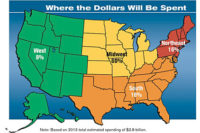The burden of federal regulations was a hot topic on the campaign trail this year. Sadly, regulations are like the weather. Many politicians complain about overregulation, but few do anything about it. Now, one organization has at least tried to put a price tag on it.
The Manufacturers Alliance for Productivity and Innovation (MAPI) has just released a study examining the qualitative and quantitative impact of major federal regulations on the U.S. economy in general and the manufacturing sector in particular. The study, Macroeconomic Impacts of Federal Regulation of the Manufacturing Sector, focused on five types of regulation that have the most significant impact on the manufacturing sector: financial, labor, energy, environmental and transportation. (Download the report at www.mapi.net.)
To estimate the cumulative cost of federal regulations affecting the manufacturing sector, MAPI analyzed more than 30 years of regulations, and developed several alternative calculations of the direct costs of major regulations. This data was then input into a general equilibrium model of the U.S. economy to evaluate the macroeconomic consequences of major regulations.
The study’s findings were startling:
The pace of federal regulations is accelerating. An average of 72 major regulations per year have been promulgated since 2009, compared to an average of 45 per year between 2001 and 2008, and 36 between 1993 and 2000.
This increase in federal regulations has hurt manufacturing output, especially in energy-intensive sectors. In 2012 alone, regulation may reduce manufacturing output by between $200 billion and $500 billion, and manufacturing exports may be 6.5 percent to 17 percent lower than they would be without the regulatory burden.
In terms of the broader economy, regulations may reduce GDP by between $240 billion and $630 billion this year, and cut the average household’s purchasing power by between $1,800 and $5,000.
It should be noted that the study’s estimates did not factor in the benefits of regulations. So let me be clear: Some regulation is absolutely warranted and necessary. We must not sacrifice necessities like clean air, clean water or worker safety for the sake of profit. If the developing world is willing to mortgage such requirements for short-term gains, then so be it. Such is the cost of taking the moral high ground.
Nevertheless, we urge our newly elected leaders to overhaul existing regulations to reduce their burden on manufacturers, and we advise them to be judicious in implementing any new regulations so as to not simply add to the burden while achieving no measurable benefits.
We’d also like to hear your thoughts. We hear a lot of complaining about burdensome regulations, but not many specifics. What regulations do you find particularly onerous, unnecessary or ridiculous? What do they cost you? How would you fix the problem? Share your experiences on the blog page of our Web site: www.assemblymag.com.
Regulation Strangulation




